NML Review | University of Nirma: Nano-biological Carriers for Lung Cancer Management
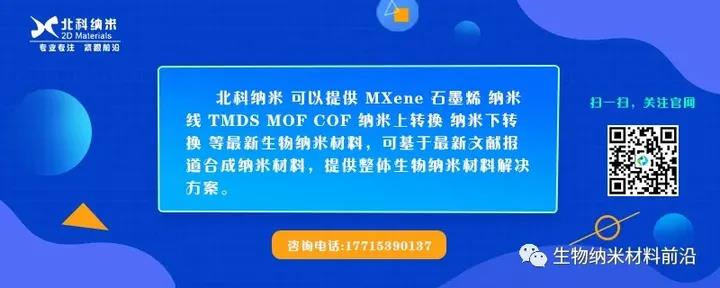
The incidence of cancer is rising globally. Lung cancer is considered to be one of the deadliest forms of cancer, with complex clinical effects and poor prognosis. Nano-bioengineering is an applied science. Through the design of new nano-biological tools and strategies, it can assist in the clinical treatment and innovate the diagnosis of lung cancer. Nano-bioengineering has currently studied many new types of bio-nano devices and expanded their applications to radiation therapy, immunotherapy, phototherapy, gene therapy, and combination therapy, as well as new therapies that promote multi-modal tumor targeting for lung cancer. The search for suitable targeted treatment strategies has also led to the development of new types of nanocarriers called "nanobiological carriers". Among them, nano-biological carriers are mostly bio-engineered, bionic, bio-sourced and bio-mixed nano-carriers, cells or vesicles. Different from other nano-carriers, nano-biological carriers have obvious advantages such as multiple targets, high biological interaction, strong biocompatibility, inherent camouflage and scalability.
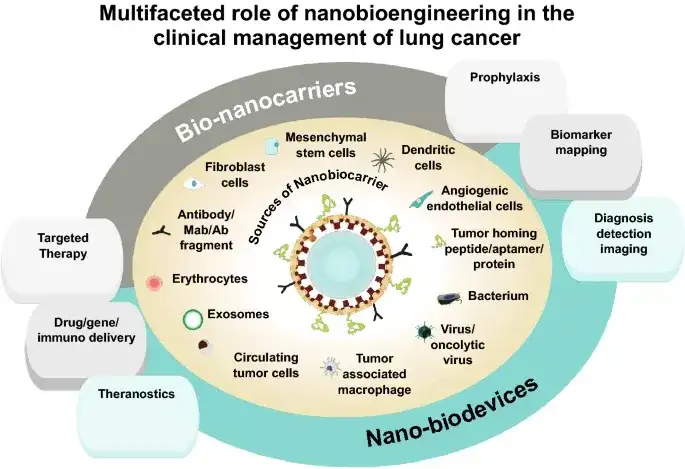
Shruti Rawal, Mayur Patel*
Nano-Micro Letters (2021)13: 142
https://doi.org/10.1007/s40820-021-00630-6
I Challenges of current lung cancer management methods
Nanocarrier-based therapy, biological therapy, and immunotherapy have become clinically adjuvant and neoadjuvant therapy for surgery and radiotherapy. With the emergence of new targeted biologics and immunotherapeutics for the treatment of non-small cell lung cancer (NSCLC), treatment outcomes and patient survival rates have improved considerably. However, treatment options for other subtypes of lung cancer such as small cell lung cancer (SCLC) and malignant pleural mesothelioma still need to be improved. Therefore, a deeper understanding of the cellular, genetic, and molecular changes in the occurrence, progression, and metastasis of lung cancer is essential to facilitate the identification of new targets.
The concepts of therapeutic drug monitoring and therapeutic diagnostics are still in their early stages of development and require extensive research. In this case, it is vital to seek bio-nanotechnology to prevent, diagnose and treat lung cancer.

Microbial-based nanosystems are gradually being used in clinics. Among them, different microbial nanobiological carriers that have been used to treat malignant tumors include: bacteria, bioengineered bacteria, bacterial microcells, S-membrane-derived nanovesicles, and magnetosomes , Bacterial ghosts, bacterial-derived outer membrane vesicles (proteoliposomes) (OMV), bacterial polymers, bioengineered viruses, bacteriophages and viruses, and fungi and yeasts. Because of the innate nature of microorganisms to specific cells/organs, as well as the advancement of bioomics and bioengineering technology, the carrier potential of microbial nanosystems has been enhanced.
Currently, targeted tumor vectors derived from cells and cell membranes include red blood cells (as shown in Figure 2), white blood cells (WBC), monocytes/macrophages, dendritic cells, neutrophils, lymphocytes, and platelets. , Mesenchymal cells (MSC), cancer cells, extracellular vesicles and exosomes-derived nano-biological carriers. In addition to biomimetic camouflage, cell-based nano-biological carriers also exhibit excellent biocompatibility, multi-molecule and inherent targeting capabilities, self-stealth capabilities, and the ability to integrate host organisms that are beneficial to a variety of tumor applications.
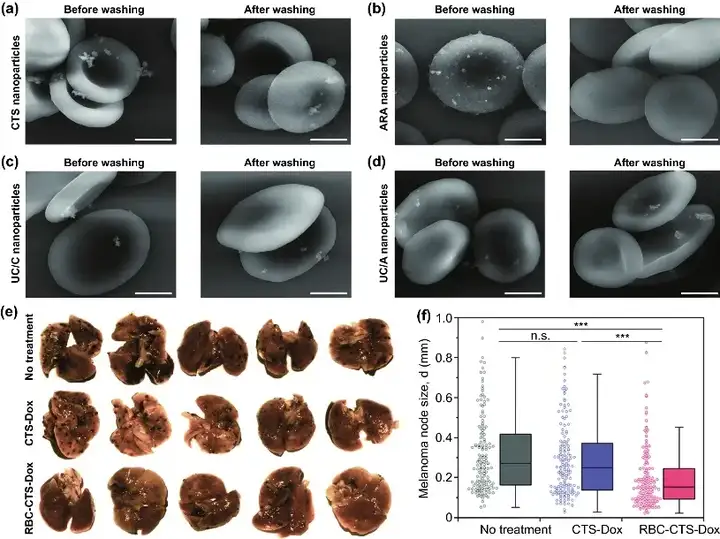
Conventional nanosystems/nanoparticles are modified to promote tumor targeting through natural, bioengineered, bioinspired or bio-derived biomolecules. In order to effectively target tumors, nano-biocarriers can be one of the following subtypes: conjugate (drug-biopolymer), nano-reservoir (biomolecules used as corona/surface coating) or nano-matrix (Nanosystems are made entirely of biomolecules). Among them, biomolecules include antibodies, lipoproteins, proteins and peptides, lung surfactants and vitamins, etc. Conventional nanocarriers that can be modified by biomolecules include lipid-based nanoparticles, polymer nanoparticles, and the like.
Nano-biological devices are small tools, devices, designs or their components manufactured for various clinical and biomedical applications through bio-nanotechnology. According to the construction materials, nano-biological equipment includes four types based on microorganisms, immunosensors, DNA and tissues.
Through nano-biological carriers, cancer vaccines and immunotherapies are developed. These vaccines and immunotherapies have therapeutic and preventive effects on high-risk patients (malignant tumors). Therefore, nano-biological carriers can be used for secondary prevention of lung cancer. A vaccine based on mannose nanoparticles (as shown in Figure 3) can promote the delivery of dendritic cells and stimulate an immune response against cancer cells.

Through nano-biotechnology, improve the ability of biological imaging and identification of tumor-related molecular markers, and finally realize the nano-biological diagnosis and personalized treatment of lung cancer. Figure 4 has developed a new type of nano-biohybrid to promote multimodal (MRI imaging and micro-PET) imaging of lung cancer.
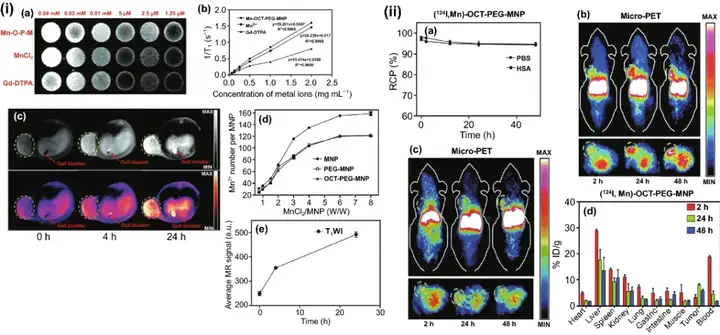
Nano-bioengineering not only helps drug development, but also promotes drug delivery. So far, four generations of nanocarriers have been developed to promote the transformation of tumor therapy from "passive targeting" to "active targeting". Nano-bioengineering and bio-nanotechnology are used in various types of treatments (such as chemotherapy, phototherapy (as shown in Figure 5), immunotherapy, gene/epigenetic therapy (as shown in Figure 6), and radiotherapy (as shown in Figure 7). ), combination therapy and new anti-cancer therapy (as shown in Figure 8)), it has versatility and multi-modal applicability.



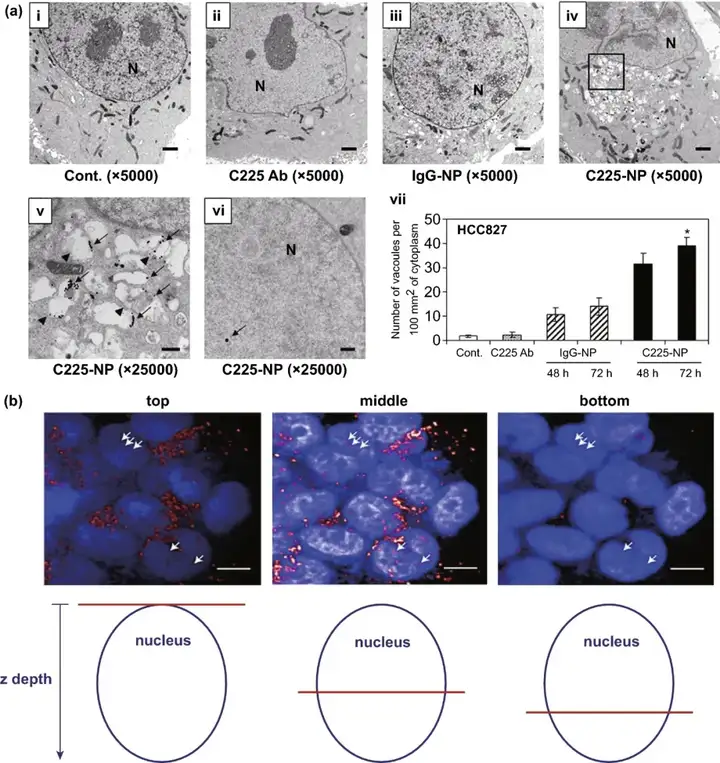
Nano-biotherapeutics refers to the unified diagnosis and therapeutic application of a single agent. Nano-biotherapeutics currently used include inorganic nanoparticles, nanocages, nanoshells, silica, liposomes, dendrimers, micelles, and other biologically composed metal-organic frameworks. With the advancement of bio-nanotechnology, virus-based and protein-based nano-biological carriers have been used in the treatment and diagnosis of lung cancer.Figure 8. A nano-biological carrier targeting EGFR has been developed to exert synergistic anti-cancer activity by inducing apoptosis and autophagy.
Nano-biotherapeutics refers to the unified diagnosis and therapeutic application of a single agent. Nano-biotherapeutics currently used include inorganic nanoparticles, nanocages, nanoshells, silica, liposomes, dendrimers, micelles, and other biologically composed metal-organic frameworks. With the advancement of bio-nanotechnology, virus-based and protein-based nano-biological carriers have been used in the treatment and diagnosis of lung cancer.
With the development of nano-biological science and bio-nanotechnology, obstacles in tumor targeting methods can be greatly overcome, and it has great potential to change the current state of tumor treatment. At present, a large number of different nanotools and new nanosystems have been widely explored to solve various problems faced by traditional therapies and applied to the prevention, diagnosis, treatment and various aspects of tumors (including lung cancer). Bio-nanotechnology tools can use molecular diagnostics and advanced bioimaging technology to design new treatment strategies to enhance tumor treatment. Nano-biological carriers are a useful means to solve tumor heterogeneity through personalized and customized drug delivery. At the same time, the transformational application of nanomedicine is also facing great challenges, and the knowledge integration with interdisciplinary researchers needs to be strengthened. With the development of nano-biological science and bio-nanotechnology, obstacles in tumor targeting methods can be greatly overcome, and it has great potential to change the current state of tumor treatment. At present, a large number of different nanotools and new nanosystems have been widely explored to solve various problems faced by traditional therapies and applied to the prevention, diagnosis, treatment and various aspects of tumors (including lung cancer). Bio-nanotechnology tools can use molecular diagnostics and advanced bioimaging technology to design new treatment strategies to enhance tumor treatment. Nano-biological carriers are a useful means to solve tumor heterogeneity through personalized and customized drug delivery. At the same time, the transformational application of nanomedicine is also facing great challenges, and the knowledge integration with interdisciplinary researchers needs to be strengthened.
Written by: "Nawei Express (English)" Editorial Department
Editor: "Nawei Express (English)" Editorial Department
This information is sourced from the Internet for academic exchanges. If there is any infringement, please contact us to delete it immediately
18915694570
Previous: Chen Xueyuan/Lu Shan A


